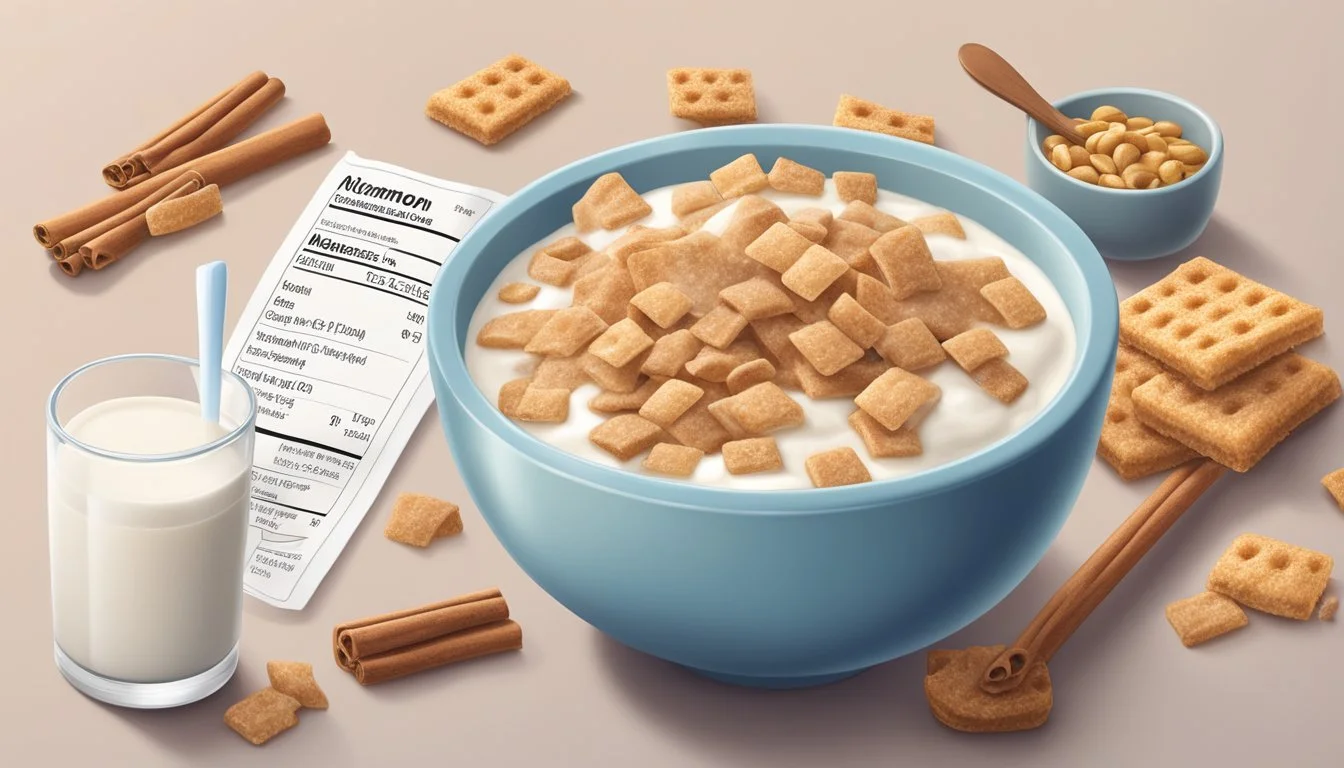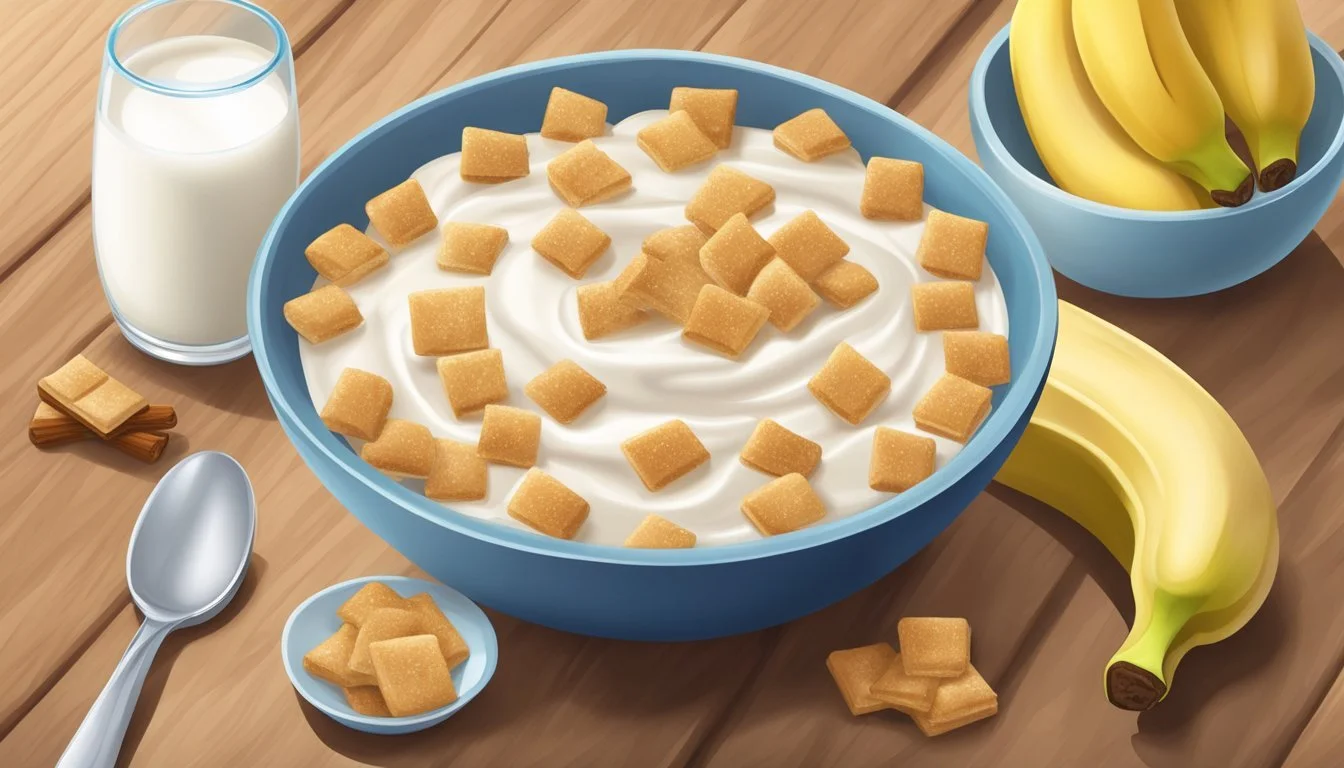Cinnamon Toast Crunch Nutrition Facts & More
Key Facts About This Popular Cereal
Cinnamon Toast Crunch, the beloved breakfast cereal from General Mills, has been a staple in many households for decades. Its sweet cinnamon flavor and crunchy texture have made it a fan favorite among both children and adults. One cup (41g) of Cinnamon Toast Crunch contains 170 calories, 12g of sugar, 3g of fiber, and 2g of protein.
The cereal's nutrition facts reveal a mix of positive and negative aspects. On one hand, it provides 10% of the daily value of vitamin D and contains whole wheat as an ingredient. On the other hand, its sugar content may be a concern for those watching their intake.
For individuals following specific diets, it's worth noting that Cinnamon Toast Crunch contains vitamin D3 derived from lanolin, which comes from sheep's wool. This information may be relevant for strict vegans considering this cereal as a breakfast option.
Cinnamon Toast Crunch Compared to Other Breakfast Cereals
Cinnamon Toast Crunch vs French Toast Crunch: Which is better?
Cinnamon Toast Crunch vs Honey Nut Cheerios: Which is better?
Cinnamon Toast Crunch vs Kellogg's Apple Jacks: Which is better?
Cinnamon Toast Crunch vs Kellogg's Froot Loops: Which is better?
Cinnamon Toast Crunch vs Post GrapevsNut Flakes: Which is better?
Cinnamon Toast Crunch vs Post Raisin Bran Cereal: Which is better?
Nutritional Profile
Cinnamon Toast Crunch cereal provides a mix of macronutrients and micronutrients. It contains various vitamins and minerals, though sugar content is notable.
Macronutrients
A 31-gram serving (about 3/4 cup) of Cinnamon Toast Crunch contains 130 calories. The cereal provides 3 grams of total fat, including 0.5 grams of saturated fat. It contains no trans fat.
Carbohydrates make up the majority of the macronutrient content. Each serving contains 25 grams of total carbohydrates, including 2 grams of dietary fiber and 9 grams of sugars.
The protein content is relatively low at 2 grams per serving.
Vitamins and Minerals
Cinnamon Toast Crunch is fortified with several vitamins and minerals. It provides 10% of the Daily Value (DV) for vitamin A, vitamin C, vitamin D, and calcium.
The cereal also contains iron, with each serving providing 10% of the DV. Other minerals present include zinc and phosphorus.
B vitamins are notable in the nutritional profile. Thiamin, riboflavin, niacin, vitamin B6, and folic acid are added to the cereal.
Sodium content is moderate at 190 mg per serving, which is 8% of the DV.
Understanding the Nutrition Label
Reading a nutrition label provides essential information about the nutritional content of Cinnamon Toast Crunch. This data helps consumers make informed decisions about their dietary intake and understand how the cereal fits into their overall nutrition plan.
Daily Values Explained
The % Daily Value (%DV) on nutrition labels shows how much a nutrient in one serving contributes to a daily diet. For Cinnamon Toast Crunch, these values are based on a 2,000 calorie diet. Key nutrients like total fat, saturated fat, cholesterol, sodium, and carbohydrates are listed with their corresponding %DV.
A %DV of 5% or less is considered low, while 20% or more is high. For example, one serving of Cinnamon Toast Crunch provides 5% of the daily value for total fat, which is relatively low.
Serving Size and Servings Per Container
The serving size for Cinnamon Toast Crunch is typically 1 cup or about 41 grams. This standardized amount allows for easy comparison with other cereals. The number of servings per container is also listed, usually around 13 for a standard box.
It's important to note that many people may consume more than one serving in a sitting. Nutritional values should be adjusted accordingly if multiple servings are eaten.
Added Sugars and Carbohydrates
Cinnamon Toast Crunch contains both natural and added sugars. The nutrition label distinguishes between total sugars and added sugars. A single serving provides about 12 grams of total sugars.
Carbohydrates make up a significant portion of the cereal's nutritional content. One serving contains approximately 33 grams of total carbohydrates, which includes dietary fiber and sugars.
Fat Composition
While Cinnamon Toast Crunch is relatively low in fat, the nutrition label breaks down the fat content into different types. A serving contains about 4 grams of total fat.
The label specifies amounts of saturated fat (0.5g), trans fat (0g), polyunsaturated fat (1g), and monounsaturated fat (2.5g). This breakdown helps consumers understand the quality of fats in the cereal.
Saturated and trans fats are generally considered less healthy, while unsaturated fats (poly and mono) are often viewed as healthier options.
Ingredient Breakdown
Cinnamon Toast Crunch contains a mix of grains, sweeteners, flavorings, and additives. These ingredients combine to create the cereal's signature taste and texture.
Grains and Sweeteners
Whole grain wheat forms the base of Cinnamon Toast Crunch, providing fiber and nutrients. Rice flour is also included, contributing to the cereal's crispy texture.
The sweetness comes from multiple sources. Sugar is the primary sweetener, followed by fructose and dextrose. These simple sugars give the cereal its characteristic sweetness.
Maltodextrin, a complex carbohydrate derived from starch, is also present. It enhances texture and acts as a mild sweetener.
Flavorings and Additives
Cinnamon is the key flavoring agent, giving the cereal its distinct taste and aroma. Canola oil adds richness and helps the cinnamon-sugar mixture adhere to the cereal squares.
Salt enhances the overall flavor profile. Trisodium phosphate serves as a preservative and pH regulator.
Soy lecithin acts as an emulsifier, improving texture and shelf life. Caramel color provides the cereal's golden-brown hue.
BHT (butylated hydroxytoluene) is added to preserve freshness and extend shelf life.
Health Considerations
Cinnamon Toast Crunch's nutritional profile raises several health considerations. Its ingredients and nutritional content impact various dietary needs and potential sensitivities.
Dietary Considerations
Cinnamon Toast Crunch contains 150 calories per serving, with 3 grams of fat and 10 grams of sugar. The cereal provides 2 grams of protein and 2 grams of fiber per serving. While it offers some nutrients, the high sugar content may concern those monitoring their sugar intake.
The cereal contains whole wheat as an ingredient, which adds some nutritional value. However, it's not a significant source of protein or fiber compared to other breakfast options.
For those watching their calorie intake, portion control is important. Adding milk increases the calorie count and alters the nutritional profile.
Allergic Reactions and Intolerances
Cinnamon Toast Crunch contains wheat, which makes it unsuitable for individuals with celiac disease or gluten sensitivity. The cereal is not gluten-free.
Some people may be sensitive to cinnamon, though allergic reactions to cinnamon are rare. The artificial flavors and colors in the cereal could potentially cause reactions in sensitive individuals.
Those with lactose intolerance should be cautious if consuming the cereal with milk. Alternatives like soy or almond milk can be used instead.
It's important to check the ingredient list for any potential allergens or items that may not align with specific dietary restrictions or preferences.
Dietary Uses
Cinnamon Toast Crunch cereal can be incorporated into various dietary plans and meal patterns. Its nutritional profile allows for flexibility in consumption, though moderation is key.
Part of a Balanced Breakfast
Cinnamon Toast Crunch serves as a quick breakfast option for many. It provides carbohydrates for energy and is fortified with essential vitamins and minerals. A serving of the cereal can be paired with milk for added protein and calcium.
To boost nutritional value, consider adding fresh fruits like berries or sliced bananas. This increases fiber intake and provides natural sweetness. For extra protein, a handful of nuts or a dollop of Greek yogurt can be mixed in.
Keep portion sizes in check to manage calorie intake. A standard serving is about 1 cup (41g), containing approximately 170 calories.
Inclusion in Diet Plans
Cinnamon Toast Crunch can fit into various diet plans when consumed mindfully. For weight management, it's important to account for its calorie content and consider it as part of daily caloric goals.
The cereal's relatively low fiber content (2g per serving) means it may not promote prolonged satiety. To address this, combine it with high-fiber foods like chia seeds or bran flakes.
For those following low-fat diets, Cinnamon Toast Crunch's 4g of fat per serving aligns with reduced-fat meal plans. However, its sugar content (12g per serving) should be factored into daily sugar intake limits.
Athletes might use the cereal as a quick source of carbohydrates before or after workouts. Its easily digestible carbs can provide rapid energy.






